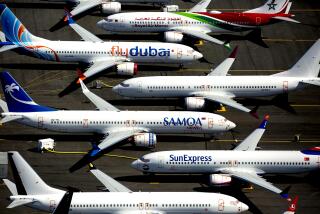New President Wants Douglas to Straighten Up and Fly Right
- Share via
Douglas Aircraft is beset by inadequate quality on its production lines, antiquated management systems, high costs, disorderly procedures, a messy factory and looming future losses if conditions don’t change.
That opinion comes not from an antagonist but from Douglas’ designated new president, Robert H. Hood Jr., who will take control of the McDonnell Douglas subsidiary May 1. Hood’s comments Tuesday were his first in public since being named the successor to Douglas’ current president, James E. Worsham.
Asked if he feels that Douglas quality meets his own personal standards, Hood said, “Quality at this time is not up to my standards.”
He added, “You can build quality into the system, or you can rework quality into the system. We certainly focus on quality airplanes and pride ourselves on building quality airplanes. The problem is that we do not have quality built into our system. We are reworking quality into it and that contributes more man-hours per airplane, more time and more cost.”
He added that he is seeking more than a 15% reduction in the hours of work it takes to build an aircraft.
Under direction from McDonnell Douglas Chairman John F. McDonnell, a top-to-bottom overhaul of Douglas has been under way for the past month. Several layers of management are being eliminated.
Hood, a thoughtful engineer and former Air Force pilot, provides a clear contrast to Worsham, a super-salesman credited with rebuilding Douglas’ commercial orders and saving the company.
With an estimated $61-billion backlog of orders and options, Douglas has now turned its attention to creating a production system that will handle a surge of anticipated future business. Since 1983, Douglas sales have soared from $1.9 billion to $4.9 billion in 1988, and the growth is continuing to accelerate. However, despite the apparent health of the company, Hood sees severe problems looming if corrective actions are not taken.
“Our systems and procedures are garbled at best,” he said at a lunch with reporters. “They are a mess.
“We are just dealing with antiquated systems--manufacturing systems, procurement systems, engineering systems. Each one has an impact on another.”
As he walks through the huge Long Beach factory where Douglas is producing the MD-80 and the MD-11 jetliners, Hood said he finds that it not clean and orderly enough, indications of deeper problems.
“I don’t want to see any paint peeling off the wall,” he said. “I don’t want to walk to the cafeteria and see paper on the ground. You wouldn’t do that at your own home.”
Hood said it was taking too long to get communications from top management down the line, part of a pattern he said has existed since McDonnell bought Douglas in 1967.
A host of problems in procedures have resulted in high production costs and inadequate quality, he said. Customers “could be happier” about quality and about timely deliveries, Hood acknowledged.
He said there “isn’t any guessing” about the fact that Douglas will lose money if it does not improve productivity and bring down costs. “ . . . We are pulling ourselves into the position of selling airplanes for less than we can make them for,” he said.
For example, the company’s most recent estimates of the cost to complete the T-45 Navy jet trainer program show that the company is now exceeding its target, though it is not in a loss position yet.
The C-17 Air Force transport program is now four to six months behind schedule in its development, which is likely to result in a partial suspension of contract payments by the Air Force. The program is also facing a stretch-out due to federal budget cutting.
“Right now, it is costing us too much and taking too long to build an airplane,” Hood said.
Douglas derives 40% of its revenues from military programs, but that proportion will decline in future years as commercial aircraft deliveries start to increase.
Hood said he does not have a long-range goal to overtake Boeing, the predominant manufacturer of airliners, but he said he would like to accomplish that.
More to Read
Inside the business of entertainment
The Wide Shot brings you news, analysis and insights on everything from streaming wars to production — and what it all means for the future.
You may occasionally receive promotional content from the Los Angeles Times.











